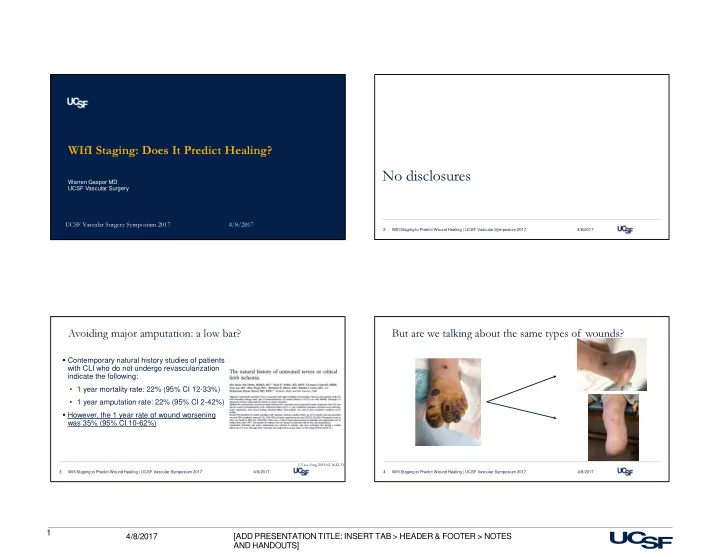

WIfI Staging: Does It Predict Healing? No disclosures Warren Gasper MD UCSF Vascular Surgery UCSF Vascular Surgery Symposium 2017 4/8/2017 2 WIfI Staging to Predict Wound Healing | UCSF Vascular Symposium 2017 4/8/2017 Avoiding major amputation: a low bar? But are we talking about the same types of wounds? � Contemporary natural history studies of patients with CLI who do not undergo revascularization indicate the following: • 1 year mortality rate: 22% (95% CI 12-33%) • 1 year amputation rate: 22% (95% CI 2-42%) � However, the 1 year rate of wound worsening was 35% (95% CI 10-62%) J Vasc Surg 2015;62:1642-51 3 WIfI Staging to Predict Wound Healing | UCSF Vascular Symposium 2017 4/8/2017 4 WIfI Staging to Predict Wound Healing | UCSF Vascular Symposium 2017 4/8/2017 1 4/8/2017 [ADD PRESENTATION TITLE: INSERT TAB > HEADER & FOOTER > NOTES AND HANDOUTS]
WIfI Classification System WIfI and Amputation � Ambitious classification system designed to reflect the multi-factorial disease that threatens a limb WIfI Predicted 1yr Stage Amputation Rate 1 3% 2 8% 3 25% 4 50% J Vasc Surg 2014;59:220-34 5 WIfI Staging to Predict Wound Healing | UCSF Vascular Symposium 2017 4/8/2017 6 WIfI Staging to Predict Wound Healing | UCSF Vascular Symposium 2017 4/8/2017 WIfI: amputation rate validation WIfI and wound healing Amputation Study, year n Overall (%) Stage 1 Stage 2 Stage 3 Stage 4 � Avoiding major amputation depends on healing of Predicted Rates ~3% ~8% ~25% ~50% the index wound and/or the surgical debridement and minor amputation Cull, 2014 158 13% 3% 10% 23% 63% � The WIfI system indirectly addresses wound healing Zhan, 2015 201 21% 0 0 8% 64% by estimating the likely benefit of revascularization Beropoulis, 2016 126 ? 0 2% 3% 12% Amputation Causey/UCSF, 2016 168 10% 0 8% 5% 20% Darling, 2016 551 15% 0 10% 11% 24% Darling, 2017 992 12% 0 4% 4% 21% Mathioudakis, 2017 279 6.5% 6% 5% 8% 6% Ward, 2017 98 27% 0 14% 21% 34% J Vasc Surg 2015;62:1642-51 J Vasc Surg 2014;59:220-34 | Ann Vasc Surg 2016; 36: 190–198 7 WIfI Staging to Predict Wound Healing | UCSF Vascular Symposium 2017 4/8/2017 8 WIfI Staging to Predict Wound Healing | UCSF Vascular Symposium 2017 4/8/2017 2 4/8/2017 [ADD PRESENTATION TITLE: INSERT TAB > HEADER & FOOTER > NOTES AND HANDOUTS]
WIfI, ischemia and wound healing WIfI Classification System: wound healing at 1 year Study, year n Overall Stage 1 Stage 2 Stage 3 Stage 4 Predicted Rates n/a n/a n/a n/a Cull, 2014 158 79% 92% 78% 65% 38% Darling, 2016 463 37% 100% 42% 39% 30% Zhan, 2015 201 ? ~97% ~97% ~92% ~85% Ramanan/UCSF, 2017 157 55%* 80% 75% 77% 81% Mathioudakis, 2017 279 85% 94% 93% 83% 70% *complete index wound healing, includes ulcer recurrences J Vasc Surg 2015;61:939-44 | J Vasc Surg 2017; in press J Vasc Surg 2015;62:1642-51 9 WIfI Staging to Predict Wound Healing | UCSF Vascular Symposium 2017 4/8/2017 10 WIfI Staging to Predict Wound Healing | UCSF Vascular Symposium 2017 4/8/2017 WIfI Classification System: wound healing at 1 year WIfI Classification System: wound healing time Retrospective Study, year n Overall Stage 1 Stage 2 Stage 3 Stage 4 Cull, 2014 158 79% 92% 78% 65% 38% Study, year n Overall Stage 1 Stage 2 Stage 3 Stage 4 Darling, 2016 463 37% 100% 42% 39% 30% Zhan, 2015 201 ? 94 days 115 days 163 days 264 days Zhan, 2015 201 ? ~97% ~97% ~92% ~85% +/- Revasc Ramanan/UCSF, 2017 157 116 days 31 days 49 days 130 days 111 days Ramanan/UCSF, 2017 157 55%* 80% 75% 77% 81% Mathioudakis, 2017 279 124 days 90 days 94 days 125 days 190 days Mathioudakis, 2017 279 85% 94% 93% 83% 70% *complete index wound healing, includes ulcer recurrences J Vasc Surg 2015;62:1642-51 J Vasc Surg 2015;62:1642-51 11 WIfI Staging to Predict Wound Healing | UCSF Vascular Symposium 2017 4/8/2017 12 WIfI Staging to Predict Wound Healing | UCSF Vascular Symposium 2017 4/8/2017 3 4/8/2017 [ADD PRESENTATION TITLE: INSERT TAB > HEADER & FOOTER > NOTES AND HANDOUTS]
WIfI Classification System: wound healing time WIfI and wound healing: is lesionology enough? � WIfI classification provides a systematic assessment of the threatened limb • As expected, revascularization is associated with improved healing times Study, year n Stage 1 Stage 2 Stage 3 Stage 4 � WIfI classification alone does not provide an assessment of the patient attached to the wound Time Revasc Time Revasc Time Revasc Time Revasc • High prevalence of diabetes and end stage renal disease in this population � Zhan, 2015 201 94 d ~2% 115 d ~2% 163 d 45% 264 d 37% low albumin, elevated inflammatory biomarkers, extensive microvascular Ramanan/UCSF, 2017 157 31 d 29% 49 d 75% 130 d 64% 111 d 90% disease � WIfI classification does not provide an assessment of the providers caring for the Mathioudakis, 2017 279 90 d 6% 94 d 12% 125 d 17% 190 d 55% patient • Multi-disciplinary teams reduce the amputation rate and improve care J Vasc Surg 2015;62:1642-51 J Vasc Surg 2015;62:1642-51 13 WIfI Staging to Predict Wound Healing | UCSF Vascular Symposium 2017 4/8/2017 14 WIfI Staging to Predict Wound Healing | UCSF Vascular Symposium 2017 4/8/2017 Summary � Data available so far indicate that there is a direct correlation between WIfI classification system stage and rate of amputation � The correlation between WIfI score and wound healing is not simple • Revascularization improves the rate of wound healing • After revascularization, patient and healthcare system factors determine the time to healing � Restaging of WIfI after an intervention may help predict wound healing and recurrence rates J Vasc Surg 2015;62:1642-51 15 WIfI Staging to Predict Wound Healing | UCSF Vascular Symposium 2017 4/8/2017 4 4/8/2017 [ADD PRESENTATION TITLE: INSERT TAB > HEADER & FOOTER > NOTES AND HANDOUTS]
Recommend
More recommend